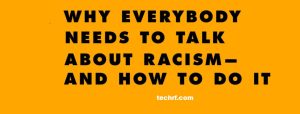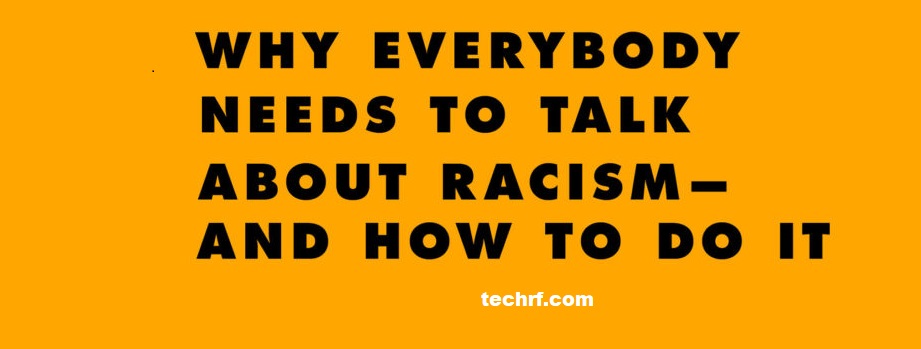It’s no surprise that talking about racism can be uncomfortable. When you dive into a subject that has centuries of painful history, emotions are bound to arise. As a white person, I know firsthand how easy it is to ignore racism. I have the ability to overlook the painful and crazy experiences that people of color face every day. However, I also realize that ignoring it is what has kept racism alive in all its hidden and insidious forms. But what do you do when you’re talking to someone who still seems ready to overlook racism? If you’re white, you almost certainly have friends or family members who don’t seem to think racism is a problem. In this blog, I will give suggestions on how to talk about racismwith people who don’t think it’s a big deal.

Talking about racism is emotional
First, I want to acknowledge why it is difficult to talk about racism. It’s no secret that the debate about racism is often emotionally charged. For people of color, racism is naturally painful and, from what I understand, a daily experience. These everyday experiences are not always overt forms of racism, such as being called insults or subjected to racist violence. These overt forms of racism, which are hard to overlook, are not the whole picture.
The way racism plays out in everyday life can be seen in many less visible ways. A shopkeeper follows you. You are overlooked for a raise or promotion at work. Your application for an apartment is rejected without any explanation. A doctor is talking to you. You fear that an ordinary encounter with the police could lead to arrest, beating or murder. These and many other experiences are forms of racism. All of these experiences are painful, and rightfully so. When you don’t experience these everyday forms of racism yourself, it’s easy to turn a blind eye.
Read more about racial trauma
For whites and others with racial privilege, the topic of racism can also evoke many emotions. There is the guilt of not being subjected to these experiences just because of how you look. The frustration that there is little you can do as an individual to fix the bigger problem. The anger that can come from admitting that the privileges you enjoy almost all come at the expense of someone else’s well-being. None of these are particularly pleasant things. And one element of racial privilege is having the choice not to feel those things if you don’t want to. But choosing that makes you a bad ally for your fellow humans.
Racism and defenses
A psychological defense mechanism (or “defense” for short) is something we do to avoid an emotion. Defense can take many forms. Changing the subject or avoiding a conversation is a defense. Putting all the blame on one person for a complex problem is a defense. Getting numb by getting high or drunk can also be a defense. When it comes to the discomfort of talking about and acknowledging racism, defenses can play a big role. Avoidance, minimization, and deflection are common defenses that play a role in conversations about racism. Combined with racial privilege, defenses help people escape from confronting their most uncomfortable feelings about racism.
One place to start might be to consider how these defenses appear in conversations about race. Phrases like “racism is over,” “everyone’s too sensitive these days,” or “you can’t say anything without someone getting upset” are likely to come from a defensive position. When someone is in “defense mode,” they probably feel protected in some way. When a person does not recognize the impact of racism, it may be because it would be painful. It can be difficult for them to reconcile these truths with their view of themselves as a good person. In cases like this, there may be an opportunity to redefine that way of thinking.
Using curiosity
One reason defensiveness can derail a conversation is because defensiveness is usually contagious. When two people disagree on something, the one person who gets defensive usually leads both people to get defensive. And that makes sense. When we feel attacked, we want to fight back. I know that when I hear a phrase like “racism is no big deal,” I immediately feel angry.
A good communication skill for dealing with defensiveness is to use curiosity. “What makes you think that?” “Can you explain more?” “What do you mean by that?” “Do you think that always happens?” Any of these questions can be helpful when you feel a defensive impulse.
There are a few reasons why curiosity can be useful here. One reason is that it shows you care about giving the other person a chance to share their point of view. Instead of immediately moving in to debunk what they say, you give them a chance to explain it first. If they feel heard, they may be more open to listening. Another reason curiosity can help is that sometimes people who hold these views haven’t bothered to explore them before. Because the subject is painful, many people try not to think too much about it. By asking questions that prompt them to explain Whybelieve what they do, you might bump into some of the flaws in their logic without you having to do it for them.
A third reason to use curiosity is that it gives you some emotional space. Being curious keeps the focus on the other person. This can buy you some time to think about how you want to respond. This can reduce the likelihood that you will react impulsively or ineffectively and regret it later.
Use of self-disclosure
Another good skill for conversations like this is self-disclosure. By that, I mean speak from your perspective. In discussions about racism, it can be tempting to focus on the other person’s way of thinking and try to convince them that they are wrong. Unfortunately, this rarely works because they are likely to feel attacked and become – you guessed it – defensive. Although your feelings are valid, it may be more effective to express them in a different way.
By self-disclosing, you can share with them your own feelings and experiences on the subject. For example, you can let them know how you feel about the impact of racial prejudice. Or describe how your friends have been affected by racism and how you feel about it. Can you describe how you would feel if you lived in fear that you or your children would be killed during a routine police encounter? You can also share with them your feelings about their point of view. Saying something like, “I feel so __(sad/angry/etc) to hear you say that,” can be a more disarming alternative than saying, “you’re wrong.”
Another great way to use self-disclosure is to share any way you relate to the other person. This can be especially helpful when dealing with something like internalized racism or implicit bias. It can be hard to swallow to realize that we all have racist thoughts, especially when you see yourself as a good person. By sharing that you also stereotype or make assumptions about people based on the color of their skin, it can help normalize this for others. Many people from older generations may actually believe that they are not racist or that racism is over except in the views of extremists.
An example of self-disclosure
An example of this could be sharing that you sometimes feel scared when you pass a group of black men on the street. You may not want to feel this fear, but it just happens. But you choose not to assume that fear is the appropriate response. In fact, you know it’s something you got by the way black men are stereotyped and portrayed in movies, the news, and other media. This is not a fear response you acquired to keep you safe from a real threat. It’s something you acquired by being exposed to racist depictions of black men as dangerous. And, if you were a police officer, he might have that answer without you being aware of its origin .dangerous. Sharing this kind of experience with others could be impressive.
Know your limits and boundaries
The advice given in this blog is most likely to be effective when you talk to someone who has some openness to a different perspective. The unfortunate reality is that there is no guarantee that these conversations will work. Some people are not open to seeing things differently. When it comes to people you are deeply connected to, this can be a painful experience.
If the conversation goes well, you could consider sending them a book or other resource as a follow-up. If you feel that the conversation is not going well, it might be best to end it. This could mean taking a break and returning to the topic or ending the conversation altogether. In this case, you may need to set a boundary with this person. That boundary could be a request that they refrain from talking about race when you’re around. Or, in some cases, it could mean that you are no longer open to continuing a relationship with them. This is especially important if the person you are talking to is speaking to you in aggressive or abusive ways. This is also a real testament to how important the issue is to you,
Read a review of the book “How to be an Antiracist”
Racism is an inherently emotional topic of discussion. When emotions are running high, it can be difficult to stay grounded and present. If you are a person who cares about other people’s experiences of racism and want to help others deal with it too, I hope the tips in this blog help you navigate these conversations. Staying curious and revealing your own feelings and experiences can be a good way to navigate any defensiveness that arises. That said, not every conversation will go as you hope. If you find that the conversation is futile or even annoying, it might be time to take a break or set a boundary.
